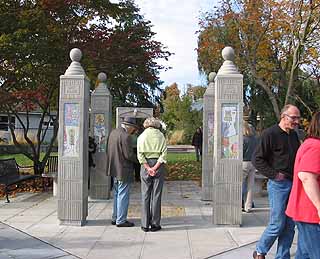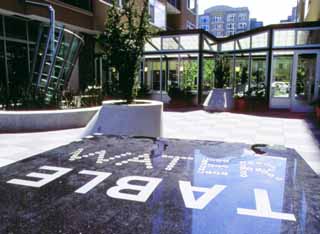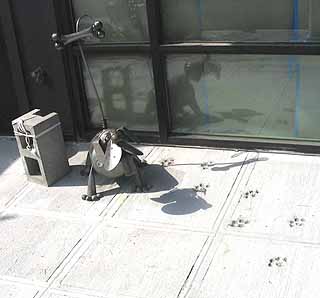
Surveys
DJC.COM
November 10, 2005
Artists, architects find a sense of place
GGLO

Image scourtesy GGLO
Stephen McClellan created the mosaic tile art found on the entry columns to the Sixth Avenue Northwest Pocket Park in Greenwood.
|
Art is an essential element of the human experience of place. Art transcends location, design and practicalities. It provides added meaning and value, becoming a vehicle for storytelling and often a touchstone for community. Art can also elicit questions, offer beauty and enrich our daily routines.
In public places, art can provide a beacon for community identity. It can help transform a mere place into "our place," an important connection that speaks to expression and encourages stewardship. A public place that is loved and used by the community will often be respected and protected.
The goal for our recently completed Sixth Avenue Northwest Pocket Park in Greenwood was to create a universally appealing neighborhood green space embraced by the community. The participation of local artists helped catalyze a neighborhood effort that brought residents together to connect with each other and take an active part in creating what they refer to as "Our Park."
Our Park includes mosaic tile on entry columns created by Stephen McClellan and inspired by renowned Pacific Northwest artist Alden Mason; whimsical tile lining the sand area created by neighborhood children; custom game tables; and an engaging stage backdrop. The art features in this park reflect neighborhood values and strong involvement, and play an important role in social gatherings, music festivals and theatrical plays.

Two Buster Simpson sculptures — a “water table” fountain and a glass with a drinking straw — can be found at the Ellington apartments in Belltown. Some say art attracts those who appreciate urban culture.
|
Another neighborhood park, finishing design in the Fremont area, expresses a different commitment to art. The park's community group, Friends of Fremont Peak Park, challenged the design team to integrate art with the design. An artist was engaged from the beginning, and the result is a concept design derived from the Greek myth of Theseus and the Minotaur.
With allegory and cadence, the myth was used to physically organize the park, which spans a steep and quiet street, a stand of Douglas firs and a panoramic vista of the Olympic Mountains. Travelers are led as Theseus was by Ariadne through the labyrinth using a silver thread while stories of life and nature are revealed. Low walls, representing the ruined labyrinth as an archetype, enhance forest and view terraces. An embedded silver thread leading visitors through the park to discover a breathtaking vista complements the park's main meandering path.
Art all around
Throughout the public domain of streets, buildings and open spaces, art is often present. Elegant dragons adorning light poles in the International District, colorful pavement tiles at Westlake Plaza, water flowing from the Justice Center through City Hall; all create a sense of identity that invites people to engage with art in everyday life.
| Artwalk Dec. 1 |
|
About 30 years ago, Seattle called upon its artists to think beyond the galleries and museums that were their main forums and engage in the broader world through participation in the design process.
In the years since, the city's buildings, infrastructure and public spaces have been enriched by the collaborative efforts of architects, designers and artists. GGLO will celebrate the unfolding of the public art process at a Dec. 1 Artwalk event in its offices. A group of local artists will reflect on the interplay of art and ideas in the built environment by creating and displaying art that weaves together stories of spaces and places. |
The benefits of integrating art are not solely the purview of the public domain. The private sector offers many examples of art and artistry used to distinguish place, gain recognition and foster community acceptance. Art can inspire pride in the workplace, attract visitors to retail destinations, celebrate the unique characteristics of neighborhoods, and differentiate residential offerings. And as with public projects, art integrated as a design concept can differ radically from art expressed as a specific installation at a particular location.
Developers seeking to fit their mixed-use, multifamily, retail or commercial project into an existing neighborhood often turn to art as one way to facilitate the approval process. In the burgeoning South Lake Union area, art features are an important element of the neighborhood's goals for development of facades, landscapes and entryways.
At Alcyone — a LEED-certified a mixed-use project in the Cascade neighborhood — decorative grillwork at parking garage vents, custom light fixtures and an engaging dog sculpture on the sidewalk complement the modern design aesthetic and light-industrial heritage of the neighborhood.
Art attracts tenants

A metal dog sculpture at the Alcyone mixed-use project recalls the Cascade neighborhood’s light-industrial heritage
|
Revitalization efforts in the eclectic Belltown neighborhood owe their success in some small part to the experience of art and design that attracts those who appreciate urban culture. The Ellington, a concrete high-rise apartment building, showcases two Buster Simpson sculptures in its courtyard. These playful water features, a glass with drinking straw and a flat "water table" fountain, invite commentary on how we think of art and manage water in an urban setting.
An example that illustrates a more integrated approach to art can be found at the Pryde Johnson mixed-use condominium project in Greenlake, which will break ground early next year. Here, the owner's desire to celebrate and contribute to the unique characteristics of the neighborhood has blended with his commitment to sustainable design. The result is an artistic program that has informed many aspects of the project.
The underlying theme uses the lake and its surrounding park as a focal point, exploring the experience of movement and time. The lake plays a significant role in the history and development of this neighborhood, attracting thousands of people to move and play around its shores and connect with nature in the midst of a dense, urban setting. A collaboration of architects, landscape architects and an artist coordinator conceived an art master plan to orchestrate five separate art projects, each by an emerging artist, which will echo these relationships cohesively.
All of these projects — whether parks, plazas, streetscapes or buildings — use art as a complement to inspire design ideas and concepts. The integration of art is not incidental but is vital to responsive and evocative design. Art has the power to elevate a location into a destination, transform utility into experience, and to infuse place with the provocation of culture.
Marieke Lacasse is a landscape architect with GGLO, a multidiscipline design firm in Seattle that has created community places throughout the Pacific Northwest.
Other Stories:
- How to get more floor space in high-rise condos
- Listen closely on how to find leaky pipes
- Fitting feng shui into Western architecture
- Designing a feast for the eyes
- Design dialogues cultivate Seattle's Chinese garden
- Can the Northwest be energy independent again?
- Add an archaeologist to the design team
- Is Seattle ready to slim down its residential towers?
- New waterfront mandate: OK isn't good enough
- A modern way to fortify an old building
- Are you ready for a $30B quake?
- Try integrated 3-D design for better buildings
Copyright ©2009 Seattle Daily Journal and DJC.COM.
Comments? Questions? Contact us.